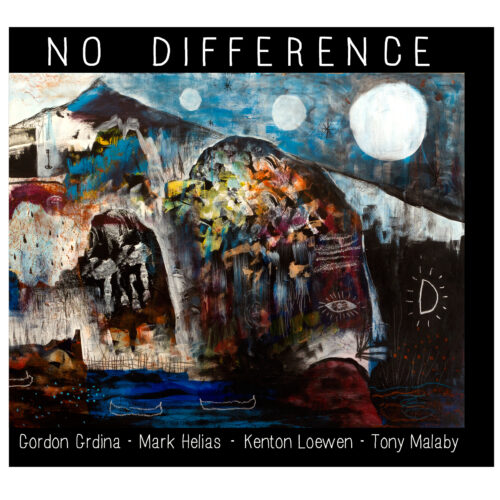Cornetist Ron Miles, bassoonist Sara Schoenbeck, and cellist Peggy Lee perform chamber works for jazz ensemble by composer-pianist Wayne Horvitz. A sense of attachment to music of the past can be heard in these pieces, which allow space for creative improvisation and rhythmic vitality within tight, thoughtful arrangements. Available in stereo and mixed to 5.0
– Mark Werlin, NativeDSD & All About Jazz
Wayne Horvitz Gravitas Quartet’s second release is more off-the-page than their 2006 debut Way Out East. Some of the new compositions sound even more like classical chamber music, but as before, improvisation plays a major role, and there’s a lot of synergy in the way the music comes together. As Wayne says, “The compositions are so open, and the band is so flexible….” The performances are classical in their precision, jazzy in their mutable blends and their grasp of expressive possibilities. Wayne’s writing is as emotionally resonant as ever, and in bringing the music to life the band spins webs of musical relationships. Ron Miles’ cornet glances back in the direction of New Orleans and early Ellington, while Peggy Lee’s cello free associates Bach, Beethoven, Bartok, and beyond. Sara Schoenbeck’s bassoon provides wittily baroque counterpoint or contemplative melodic lead, while the piano’s runs, motifs and clusters suggest links to impressionism, and occasionally to atonality. In other pieces different sets of connections take shape.
This music resists labels. Calling it jazz means that most people who follow contemporary classical or post-rock may never hear about it, which would be a shame. If it’s the Third Stream of today, it holds within its sights the new thing, free improv, and pretty much everything else that happened in jazz, popular and ‘art’ music in the twentieth century (and the 21st, given their cover here of Elliott Smith’s “A Fond Farewell”). Horvitz comments that combining jazz and classical elements is in fact “a fairly obvious process, and it’s one with a long history. The instrumentation lends itself to writing without regard to a ‘rhythm section’ mentality, and it encourages certain ambitions and desires I have as a composer. At the same time the references to so-called jazz and blues language to me are simply due to the fact of being an American composer. Blues was the first music to really move and inspire me. As my friend Philip Johnston once said to me, ‘You know how you are listening to a record of Japanese koto music and for a moment it sounds like John Lee Hooker?’ I would say the same thing about a Bartok string quartet.” When asked whether he feels more of a responsibility to the past or to the future in his work, he replies, “That’s an interesting question. I guess when all is said and done I feel a much stronger pull to the past. And as much as I’ve been interested in and inspired by innovative, experimental and so-called avant-garde music, I would have to say that the best of that music has always been the result of some kind of deep integration of what has come before with a new vision of what can be. It seems to me that’s true in Bach’s music, Schoenberg’s, Roscoe Mitchell’s, Public Enemy and even Muddy Waters.” It’s certainly true in his own.
Wayne Horvitz Gravitas Quartet
Wayne Horvitz, Piano
Peggy Lee, Cello
Ron Miles, Cornet
Sara Schoenbeck, Bassoon
Tracklist
Please note that the below previews are loaded as 44.1 kHz / 16 bit.Total time: 00:56:55
Additional information
| Label | |
|---|---|
| SKU | SGLSA15712 |
| Qualities | DSD 512 fs, DSD 256 fs, DSD 128 fs, DSD 64 fs, DXD 24 Bit, FLAC 192 kHz, FLAC 96 kHz |
| Channels | |
| Artists | Peggy Lee, Ron Miles, Sara Schoenbeck, Wayne Horvitz, Wayne Horvitz Gravitas Quartet |
| Composers | |
| Genres | |
| Original Recording Format | |
| Instruments | |
| Audio Engineer | Tucker Martine |
| Recording Location | Recorded December 14-15, 2007 at Studio Litho, Seattle. |
| Mixing | Mixed by John Raham at Ogre Studios, Vancouver. |
| Mastering | Mastered by Graemme Brown at Zen Mastering. |
| Release Date | September 6, 2024 |
Press reviews
Pop Matters
no one said that classical instruments couldn’t turn sharp and abrasive. The title track, “One Dance Alone”, bristles with staccato, every instrument turned as confrontationally terse as unpedaled piano, exploding in bursts and joining for unexpectedly lyrical interludes.
All About Jazz
Like a rainy day punctuated by clear skies and brief rays of sunshine, One Dance Alone presents Horvitz’s contemplative writing in a unique instrumental context.
Audiophile Audition
… an adventurous statement from a leading pianist and composer in the alternative jazz area … shows how a seemingly classically-oriented chamber ensemble can blend in jazz and blues elements of creative improvisation and come up with new expressive possibilities …
DownBeat
Horvitz (creates) a time-warped ambience, in which the listener feels a stillness that is languid and foreboding.(****)
The Absolute Sound
On their second release, Horvitz’s unique chamber ensemble again improvises wonderfully on his haunting compositions, plus an Elliot Smith cover. Audiophile recording and mixing bring out subtle aspects to the fullest.
Only logged in customers who have purchased this product may leave a review.










Reviews
There are no reviews yet.